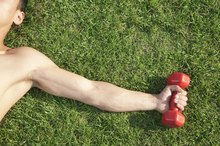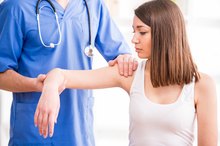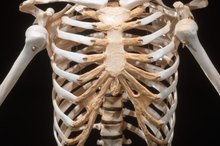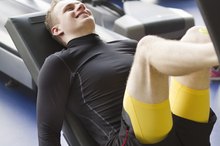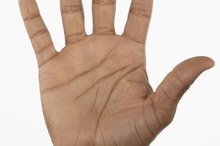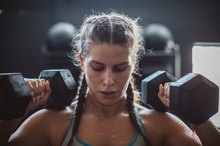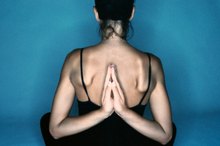Voluntary Muscles in the Body
Voluntary muscles are one of three types of muscle in the body; smooth and cardiac are the other two types. There are more than 600 muscles in the body, and each falls into one of these categories. Smooth muscles are involuntary; cardiac muscles make up the muscles in the heart; voluntary muscles are controllable by your brain — and these are the muscles you use to perform activities.
Major Muscle Groups
The muscles of the chest, back, shoulders, abdominals, arms, and legs make up the body's major muscle groups. Listing all 600-plus muscles in the human body would be difficult, not only because there are so many, but because people disagree on exactly how many there are. The major muscle groups are fairly standard, however, and these can broken down further into component muscles — for instance, the arms can be listed as the biceps and triceps.
Chest
What Are the Names of the Muscles in the Arm & Shoulder?
Learn More
The muscles of the chest are typically called the pecs, short for pectorals. The two significant muscles of the chest are the pectoralis major and pectoralis minor. The pecs account for movement in the shoulder and shoulder blades, also called the scapulae.
Back
There are many muscles of the back. The main muscles include the erector spinae, which run the length of the spine and neck, the latissimus dorsi (middle back), the rhomboids (upper back), and the trapezius (upper back and neck). The back muscles are important for posture, as well as movement of the shoulder blades, spine and shoulders.
Shoulders
What Are the Causes of Pain in the Back of the Arm?
Learn More
The shoulders join the back and chest with the arms. The name of the shoulder muscles is the deltoids. The deltoids consist of three parts: the anterior (front), medial (side), and posterior (rear). Together, these muscles account for shoulder flexion, extension, and lateral flexion, which means moving the shoulder forward, backward, and to the side.
- The shoulders join the back and chest with the arms.
- Together, these muscles account for shoulder flexion, extension, and lateral flexion, which means moving the shoulder forward, backward, and to the side.
Arms
The muscles of the arms can be separated into the upper arms and forearms. The upper arm muscles include the biceps on the front, and the triceps on the back. These muscles move the elbow. The forearm muscles, in the lower arm, move the wrist and rotate the forearm.
- The muscles of the arms can be separated into the upper arms and forearms.
- The forearm muscles, in the lower arm, move the wrist and rotate the forearm.
Legs
The main muscles of the legs include the quadriceps of the front of the thigh, the hamstrings on the back of the thigh, and the calf muscles of the lower leg. The calf muscles include the gastrocnemius and the soleus. Other leg muscles include the adductors of the inner thighs, and the abductors, which are the muscles of the glutes and outer thighs. The glutes, however, are considered core muscles, as they assist with torso stabilization and balance. Other core muscles include the spine, pelvic floor muscles, and the muscles near the spine.
- The main muscles of the legs include the quadriceps of the front of the thigh, the hamstrings on the back of the thigh, and the calf muscles of the lower leg.
- Other leg muscles include the adductors of the inner thighs, and the abductors, which are the muscles of the glutes and outer thighs.
Abs
The muscles of the stomach include the rectus abdominus, transverse abdominus, and the internal and external obliques. The rectus abdominus, nicknamed the six-pack muscle, is the visible muscle. The obliques are on the sides of the stomach, and the transverse abdominus is below the obliques. The transverse abdominus compresses the abdominal organs.
- The muscles of the stomach include the rectus abdominus, transverse abdominus, and the internal and external obliques.
- The obliques are on the sides of the stomach, and the transverse abdominus is below the obliques.
Other Voluntary Muscles
There are some important muscles, of course, beyond the major muscles. The muscles of the face, neck, and tongue are useful voluntary muscles that allow you to eat, support and move your head, and make facial expressions.
Related Articles
References
- KidsHealth: Your Muscles
- "NASM Essentials of Personal Fitness Training: Course Manual"; Michael Clark, Scott Lucett, Rodney Corn; 2008
- Schoenfeld B. Science and Development of Muscle Hypertrophy. Human Kinetics; 2016.
Writer Bio
Sarka-Jonae Miller has been a freelance writer and editor since 2003. She was a personal trainer for four years with certifications from AFAA and NASM. Miller also worked at 24 Hour Fitness, LA Fitness and as a mobile trainer. Her career in the fitness industry begin in 2000 as a martial arts, yoga and group exercise instructor. She graduated cum laude from Syracuse University.
